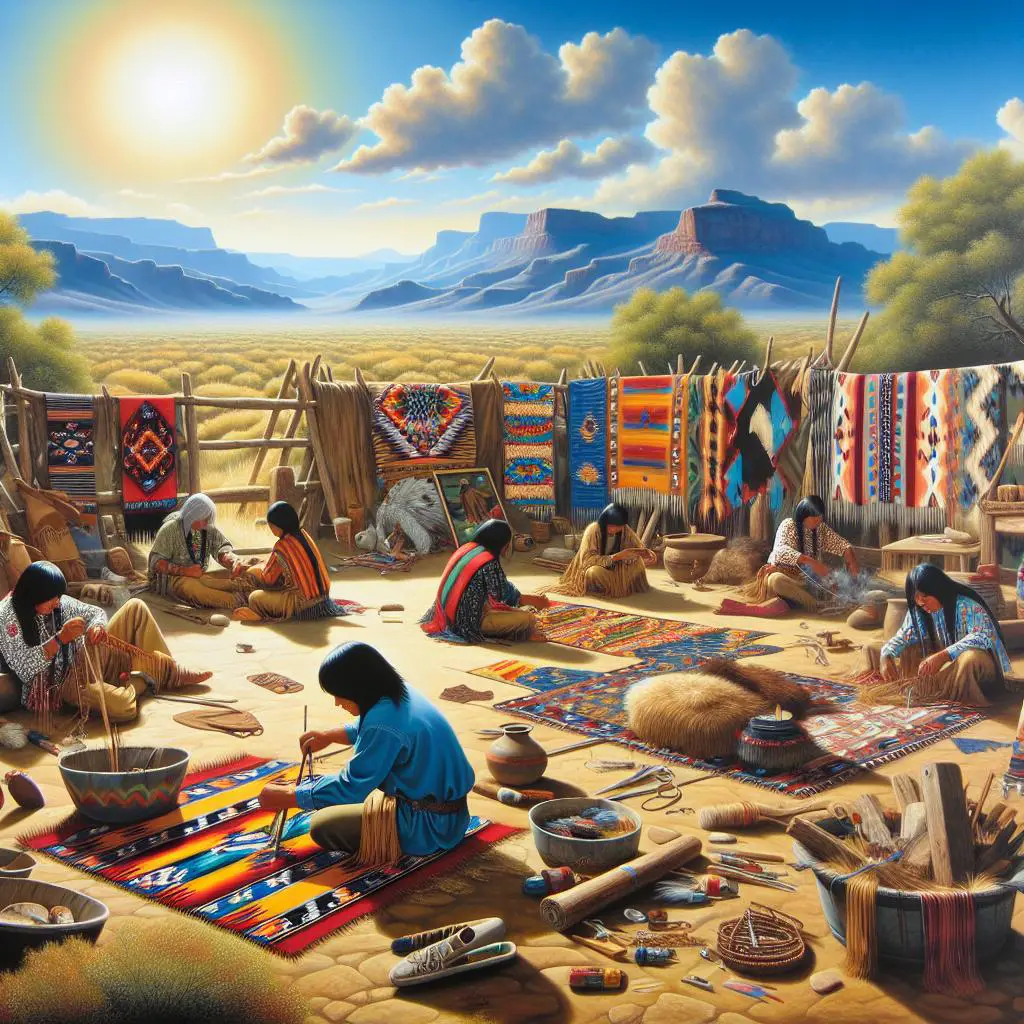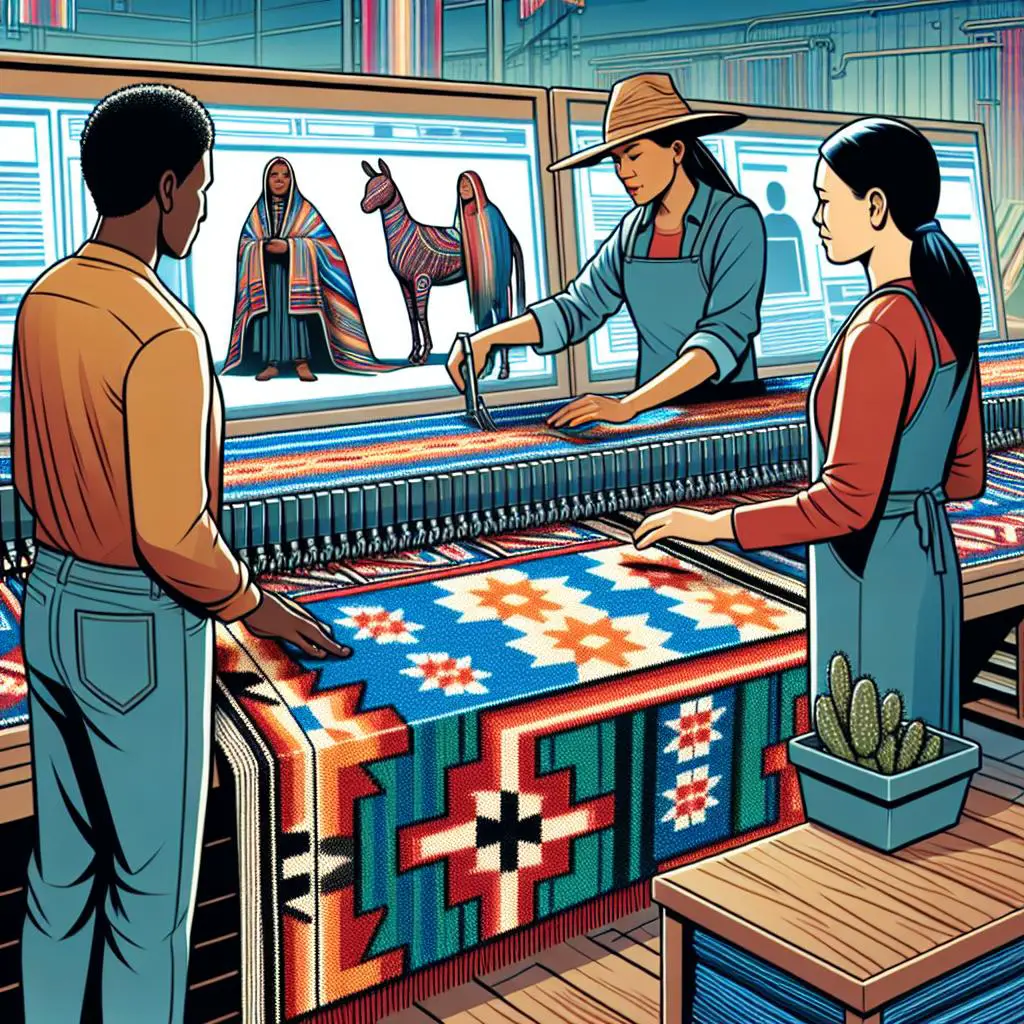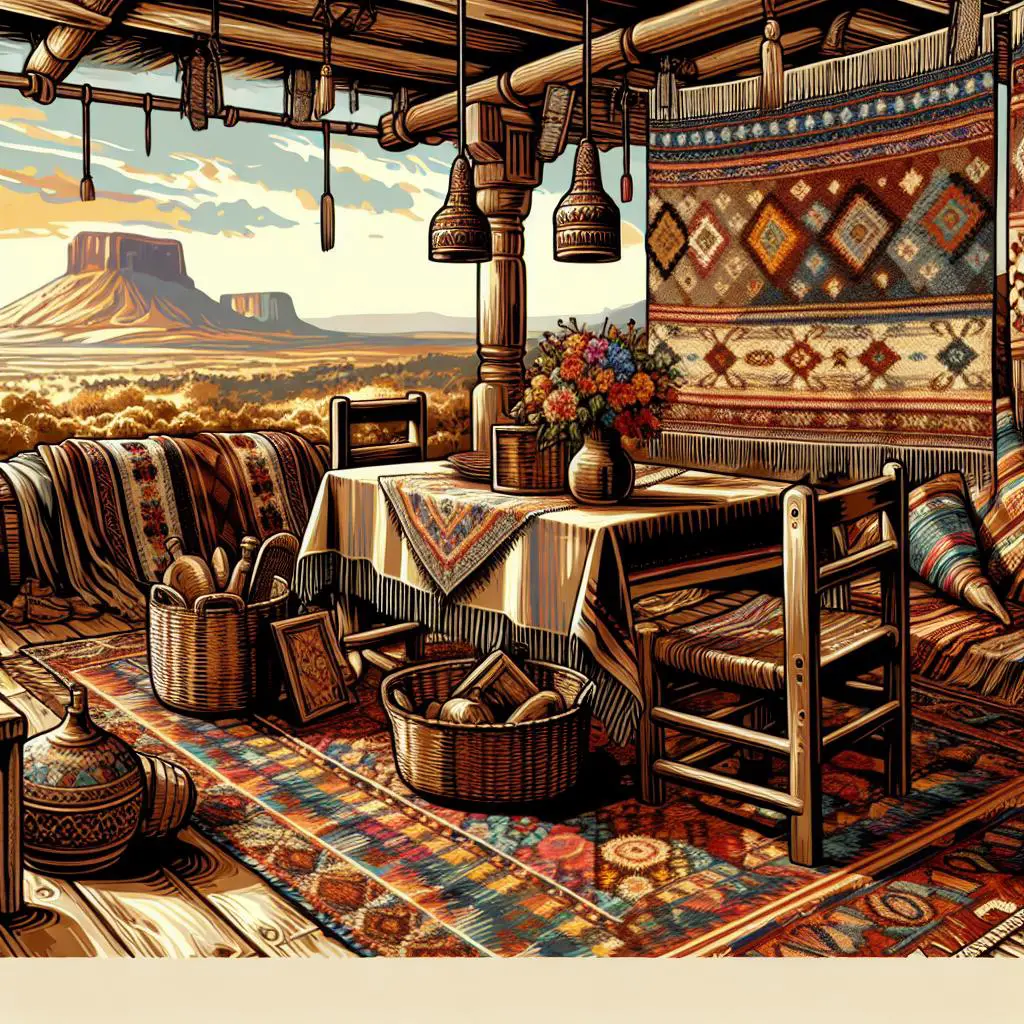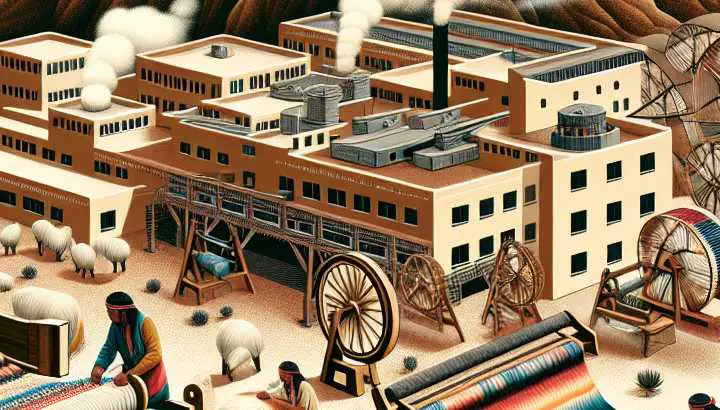The History of Blanket Making in the Southwest

1. Indigenous tribes and their blanket making traditions
Blanket-making: an ancient art form practiced by indigenous tribes mercilessly adept at transforming mere fibers into breathtaking works of usable art. If every historical figure had a Wikipedia page, these indigenous blankets would undoubtedly have their own lengthy discographies. Recorded over the ages in countless museums and private collections, these traditionally woven wonders serve as a testament to the rich cultural heritage these tribes possess. Disclaimer: If you’re expecting a bland history lesson here, you might be a little disappointed, because we’re diving into this subject the fun way.
First up: let’s trek across the snowy plains of North America and pop in on the Navajo tribe. The Navajo’s blanket craftsmanship is so renowned, you’d think they all attend a weaving boot camp from birth. Known for their intricate “Chief’s Blankets,” these incredibly detailed and colorful creations were once a status symbol among the tribe. Crafted with the finesse of a master painter and the precision of a neurosurgeon, these blankets feature horizontal stripes and diamond shapes in natural shades of black, white, brown, and indigo. If the Chief’s Blanket was a pop song, it’d be topping the Billboard charts, no questions asked.
Let’s now scoot over to the Pacific Northwest, where we find the Salish tribe performing their version of weaving wizardry. Salish blankets were the “snuggie” of the tribe; versatile, functional, and darn comfortable. Made from mountain goat wool, fireweed fluff, and dog hair – yes, you read that right, dog hair – these blankets were not only warm and cozy but also held significant cultural and ceremonial value. Basically, in Salish society, giving someone a blanket made from fluff and Fido was like handing them a love letter sealed with an invitingly warm hug.
Remember when granny tried teaching you how to knit and you ended up getting more tangled than the yarn itself? Well, the Quechua people from the Andes have turned such potential yarn-based misfortunes into an unbelievably aesthetically pleasing art form.
“In the towns there were elements which were of Roman blood, at least in part, as well as the purely indigenous peoples, who sooner or later came under the Roman influence”
~ Charles E. Chapman, A History of Spain
Fabricated from the incredibly soft alpaca wool, the Quechuan blankets often showcase vibrant colors and intricate patterns, representing everything from the local flora and fauna to astronomical symbols — nothing screams ‘goodnight sleep’ like cuddling under a blanket of alpacas and stars.
Taking a leap across the Pacific, let’s pay a visit to the Maori tribe of New Zealand. Their traditional weaving skill demonstrates that they didn’t just throw a shrimp on the barbie. No – they twirled flax fibers into a fine art form, creating striking “kakahu” or cloaks, complete with intricate patterns and dangling “hukahuka” tassels. These blankets, equally fit for an art exhibit or a fashion runway, were the epitome of fierce finesse and style.
Strolling back to North America, we end up at the Hopi Tribe, who also had a knack for blanket-making. Their woven wonders were intricately detailed, telling the tales of their people – kind of like ancient comic strips, but with way more style. Predominantly in hues of brown, black, and white, these blankets served as a canvas to their historical narratives, with geometric patterns that could make even Pythagoras jealous.
So there you have it, a whirlwind tour through the fabric-infused traditions of remarkable indigenous tribes, crafting far more than mere blankets. Every thread weaved into their masterpieces tells tales of cultural identity, heroic tales, daily toils, and tribal eccentricities. All in all, these indigenous blanket-making traditions offer proof that art really can be as cozy as a warm blanket on a cold night. And if you didn’t catch the knitting bug before, I bet you’re snuggling into your crochet right about now… or furiously googling where to buy these blankets.
Read More: 1. Indigenous Tribes And Their Blanket Making Traditions

2. Technological advancements in Southwest blanket production
Once upon a time, in the dusty plains and fiery deserts of the Southwest, a legend was hand-woven into reality – the Southwest blanket. These blanket fabrications were a tangible representation of the culture, history, and heart of the native people. And let’s be honest, who wouldn’t want to wrap themselves in a bit of art and culture every now and then, especially on those cold desert nights?
Yet, technological advancements have crept through the sand, dusting off some traditional techniques and incorporating them into today’s world. You’d think technological advancement and blanket-making do not mix right? Think again! They rolled into the blanket production like a tumbleweed in a spaghetti Western, entertainingly unexpected.
First, let’s take a moment to appreciate the traditional process. We’re talking backbreakingly difficult work, with rudimentary looms and colorful threads, all coming together under skilled hands to create the intricate designs the Southwest is famous for. It was a labor of love, an art form, with every single blanket a chapter of the rich tale of Southwestern culture and history.
Fast forward several centuries later, and we’re not just talking about looms and skilled hands anymore. Technological advancements have created an old-meets-new dynamic in the blanket production scene, bringing with them a wave of refreshing innovations. And oh boy, are they fun!
Firstly, did we mention laser-guided looms? You heard it right! We’re in an age where laser technologies are not just for cutting-edge medical procedures or making your cat scurry around the living room. Imagine a pinpoint accuracy in following the intricate art designs of Southwestern art scenes. It’s blanket production on steroids, people!
High-tech computerized design software has also nudged its way into the mix, replacing sketches on scraps of paper.
“INDEMNITY – You agree to indemnify and hold the Foundation, the trademark owner, any agent or employee of the Foundation, anyone providing copies of -tm electronic works in accordance with this agreement, and any volunteers associated with the production, promotion and distribution of -tm electronic works, harmless from all liability, costs and expenses, including legal fees, that arise directly or indirectly from any of the following which you do or cause to occur: (a) distribution of this or any -tm work, (b) alteration, modification, or additions or deletions to any -tm work, and (c) any Defect you cause”
~ Unknown, Unknown
This cheeky new technology allows artists to plot out the patterns digitally before they even reach the loom. The blanket can thus ‘exist’ before the first thread is touched. It’s an absolute game-changer, saving time while also ensuring stunning accuracy of design.
And let’s not forget the eco-friendly wave sweeping across industries, and Southwest blanket producers aren’t about to be left behind. Enter the tech-savvy dyeing techniques that use wastewater for production, not only turning waste into something beautiful but also adding a green thumb to the process.
Think we’ve replaced tradition with tech completely? Nope! With all these advancements in play, the artistry at the heart of the Southwest blanket remains the same. That’s right; lasers can’t replace the heart and soul of an artisan. Each blanket still carries the story, culture, and spirit of the Southwest, woven with intricate designs and vibrant colors.
Technology has truly wrapped its arms around the Southwest blanket industry, providing advancements that have shifted and shaped the industry. But as with any good cowboy story, the real heart lies in its roots – and in this case, it’s the blend of traditional craftsmanship with high-tech production nomadery. It’s a quintessential tale of old meets new, painting another chapter of Southwestern culture with every blanket made, one laser-accurate loom stitch at a time!
Like This? Try: 2. Technological Advancements In Southwest Blanket Production

3. Influence of Spanish colonization on blanket design
Once upon a time, in the deep recesses of history, along came Spanish conquistadors, romping into the New World with their shiny armor, bushy mustachios, and an insatiable thirst for gold. They took one look at the natives, their lush landscapes, and said, “Yup, we’ll take the lot!” Unbeknownst to them, they were not just changing the course of history, but also the face of one seemingly mundane object – the humble blanket.
That’s right! The Spanish colonization had a profound influence on New World blanket design that is still evident today. Who would have thought, right? You might snort, “Oh, please! They wove some threads together, big deal.” But to scoff at the intricacies of blanket design is to rob oneself of an exotic journey into the labyrinth of history, culture, and warmth (quite literally!).
Now let’s whisk ourselves away into times of yore and discover how that old fleece throw over your couch came to be more than just your binge-watch buddy.
1. Vibrant Colors: First stop, colors. Before the Spanish set their boots on the New World, native blankets were a symphony of natural hues: think browns, creams, and occasional blues. With the coming of the Spanish, a torrent of colors breached the calm seas. Radiant reds, delightful greens, vivacious purples – all the colors of a striking sunrise splashed onto blankets like an artist let loose on a canvas. The burst of colors came from cochineal insects, newly introduced wool-bearing animals, and the Spanish art of dyeing, creating a riot of warmth and life in the native textiles.
2. Intricate Patterns: Next, the Spanish colonization enriched the aesthetic tapestry by introducing complex weaving techniques. You see, before our Spanish friends showed up, the indigenous people were skilled weavers, no doubt about that. Still, their designs were linear, simple but elegant.
“The other coasts of Africa, including its southernmost cape, furnish points of importance to commerce, navigation, and even some attempts at colonization; while the interior parts of this continent, still so little known, possess much to excite the attention and wonder of the naturalist; but beyond this, its maritime as well as central regions, cannot be said to occupy a place in the intellectual history, or in the moral progress, of our species”
~ Unknown, Unknown
However, like guests who can’t resist showing off a few party tricks, the Spanish introduced intricate patterns and surreal designs. The result? A visually stunning symphony of geometrical precision, a testament to the power of the loom, and the culmination of two contrasting cultures.
3. Material Shift: Lastly, move over, cotton! Here comes the wool! Before the Spanish arrived with their hairy, bleating, walking – rather grazing – wool factories—yes, we’re talking about sheep — the local tribes primarily used cotton and plant fibers. The Spaniards introduced churro sheep to the natives, an animal now so closely associated with Navajo weaving that you’d think they were an old married couple.
The use of wool revolutionized the blanket industry. Woolen blankets were warmer, they had a distinct texture, and most importantly, the wool excelled at retaining the bright, newly introduced Spanish dyes. Soon, everyone wanted a woolen blanket – it was like the iPhone of the 1500s!
So there you have it! The next time you cosy up with your blanket, take a moment to appreciate its rich, layered history. After all, it’s not just a shield against the chill, but also an artifact bearing the whispers of Spanish conquistadors, native artisans, and the countless threads of history woven into its very fabric. The humble blanket, indeed!
Like This? Try: 3. Influence Of Spanish Colonization On Blanket Design
